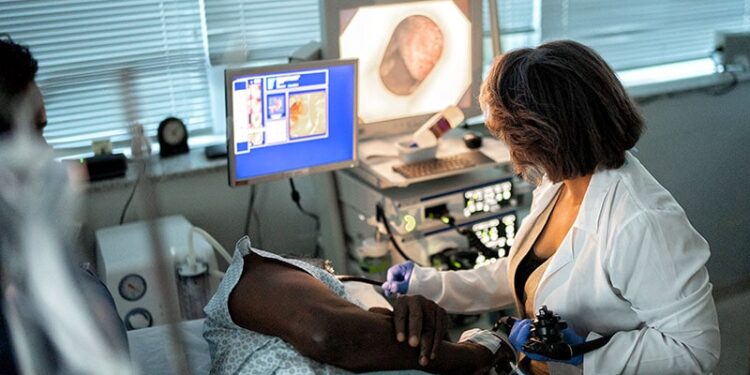SAN DIEGO—Gastroenterologists have debated the best course of action for patients with Barrett’s esophagus for decades. Which is better for detecting early malignancy and preventing progression to esophageal adenocarcinoma (EAC) — surveillance endoscopy at regular intervals or only when symptoms occur? Does one offer a better chance of survival than the other?
Now, researchers who conducted what they believe is the first randomized clinical trial comparing the two approaches say they have the answer.
Surveillance endoscopy every 2 years offers no benefit in terms of overall or cancer-specific survival, said Oliver Old, MD, a consultant upper-GI surgeon at Gloucestershire Royal Hospital, England, who presented the findings at Digestive Disease Week (DDW) 2025.
At-need endoscopy may be a safe alternative for low-risk patients, the research team concluded.
The BOSS Trial
The Barrett’s Oesophagus Surveillance Versus Endoscopy At Need Study (BOSS) ran from 2009 to 2024 at 109 centers in the UK, and 3452 patients with Barrett’s esophagus of 1 cm circumferential or a 2 cm noncircumferential tongue or island were followed for a minimum of 10 years.
Researchers randomly assigned patients to undergo upper gastrointestinal endoscopy with biopsy every 2 years (the standard of care when the trial was set up) or endoscopy “at-need” when symptoms developed. Patients in the latter group were counseled about risk and were offered endoscopy for a range of alarm symptoms.
The study found no statistically significant difference in all-cause mortality risk between the two groups. Over the study period, 333 of 1733 patients (19.2%) in the surveillance group died, as did 356 of 1719 patients (20.7%) in the at-need group.
Similarly, no statistically significant between-group difference was found in the risk for cancer-specific mortality. About 6.2% of patients died from cancer in both groups — 108 in the regular surveillance group and 106 in the at-need group.
Nor was there a statistically significant difference in diagnosis of EAC, with 40 regular surveillance patients (2.3%) and 31 at-need patients (1.8%) receiving the diagnosis over median follow-up of 12.8 years. Cancer stage at diagnosis did not differ significantly between groups.
“The really low rate of progression to esophageal adenocarcinoma” was a key finding, Old said. The rate of progression to EAC was 0.23% per patient per year, he said.
Low- or high-grade dysplasia was detected in 10% of patients in the regular surveillance group, compared with 4% in the at-need group.
The mean interval between endoscopies was 22.9 months for the regular surveillance group and 31.5 months for the at-need group, and the median interval was 24.8 months and 25.7 months, respectively. The mean number of endoscopies was 3.5 in the regular surveillance group and 1.4 in the at-need group.
Eight patients in the regular surveillance group (0.46%) and seven in the at-need group (0.41%) reported serious adverse events.
Will BOSS Change Minds?
Current surveillance practices “are based on pure observational data, and the question of whether surveillance EGD [esophagogastroduodenoscopy] impacts EAC diagnosis and mortality has been ongoing,” said Margaret Zhou, MD, MS, clinical assistant professor at Stanford University School of Medicine, Stanford, California. A randomized clinical trial on the subject has been needed for years, she added.
However, Zhou said, “In my opinion, this study does not end the debate and will not change my practice of doing surveillance endoscopy on NDBE [nondysplastic Barrett’s esophagus], which I typically perform every 3-5 years, based on current guidelines.”
The American Gastroenterological Association clinical practice guideline, issued in June 2024, addresses surveillance and focuses on a patient-centered approach when deciding on treatment or surveillance.
Patients in the at-need endoscopy arm underwent endoscopy almost as frequently as the patients randomly assigned to regular surveillance, at a median interval of about 2 years, Zhou noted. Therefore, she said, “It’s difficult to conclude from this study that surveillance endoscopy has no impact.”
Additionally, the study was underpowered to detect a difference in all-cause mortality and assumed a progression rate for nondysplastic Barrett’s esophagus that is higher than the current understanding, Zhou said. “It also did not address the important question of EAC-related mortality, which would be an important outcome to be able to assess whether surveillance EGD has an impact,” she said.
Joel H. Rubenstein, MD, MSc, director of the Barrett’s Esophagus Program and professor in the Division of Gastroenterology at the University of Michigan Medical School, Ann Arbor, agreed that the study doesn’t answer the pressing question of whether surveillance works.
While Rubenstein said he would not tell colleagues or patients to stop routine surveillance in patients with Barrett’s esophagus on the basis of these results, “it is a reminder that we should be circumspect in who we label as having Barrett’s esophagus, and we should be more proactive in discussing discontinuation of surveillance in patients based on advancing age and comorbidities.”
The study was funded by the UK’s National Institute for Health and Care Research. Zhou is a consultant for CapsoVision and Neptune Medical. Rubenstein has received research funding from Lucid Diagnostics. Old reported no disclosures.
Source link : https://www.medscape.com/viewarticle/barretts-esophagus-no-survival-difference-between-regular-2025a1000ca6?src=rss
Author :
Publish date : 2025-05-15 16:44:00
Copyright for syndicated content belongs to the linked Source.














